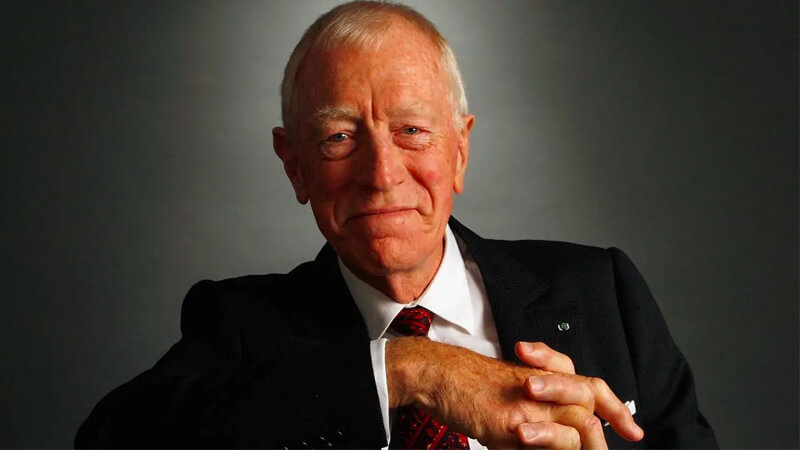Biography of Max Von Sydow:- He had studied at the prestigious Royal School of Dramatic Theater in Stockholm, where he had as his classmates some of the magnificent performers who would later achieve equal popularity with him in the Bergman films that were gradually arriving.
His film career began at the age of twenty, with a melodramatic film entitled Bara en mor (1949), which could be translated as “Only a mother” and that did not cross the borders of his country, despite being directed by the great Swedish master Alf Sjöberg.
His next film was also directed by this director and it was already a prestigious title, Fröken Julie (1951), one of several versions (and possibly the best) that have been made of the classic piece of August Strindberg .
Biography of Max Von Sydow
- Born:- 10 April 1929 (age 88), Lund, Sweden
- Height:- 1.94 m
- Nomination:- Academy Award for Best Actor in a Supporting Role
- Children:- Cédric Brelet von Sydow, Clas S. von Sydow, Henrik von Sydow, Yvan von Sydow
- Spouse:- Catherine Brelet (m. 1997), Christina Olin (m. 1951–1979)
The appearance of his spiky, spiritual figure; The calm, measured gestures; The dazzling composition of the gentleman Antonius Blok in The Seventh Seal (1957) by Ingmar Bergman revealed to the world the immeasurable talent of this Swedish actor who became almost a kind of counter-figure to spiritual or metaphysical concerns Of the Nordic director and, of course, one of the first actors from those distant countries that reached a considerable popularity.
See Also: Biography of Leonor Watling
For several years the association between Max von Sydow and the country director was constant and was solved in a few films that are among the most outstanding of Ingmar Bergman’s early days: in Wild Strawberries (1957) he played a naive and warm character.
The manager of a gas station, who considered Isak Bork (Victor Sjöstrom, true protagonist of the film) the best doctor in the world.
Another person of soft contours was the one that interpreted in the threshold of the life (1958), the husband of Eva Dahlbeck, waiting for a son like culmination of its union that is born dead.
His personification of Albert Emmanuel Vogler, the enigmatic and ambiguous hypnotist of El rostro (1958), remains another of his most memorable performances.
The fountain of the maid (1960), As in a mirror (1961) and The communicants (1963) were the three films that successively rolled to the orders of Bergman before receiving the call of Hollywood: and the proposal did not cease to be surprising .
George Stevens proposed the role of Jesus Christ in The Greatest Story Ever Told (1965). This work had two consequences: one of practical order, which meant the adoption of Von Sydow by the American cinema of great spectacle.
Another of a personal nature, and it was that the actor was obstinately determined to flee from those “spiritual” characters who seemed predestined and tried to exhibit the most perverse features of his interpretive record, in order not to be typecast.
Thanks to this we have been able to admire in his long career for American cinema the talent of Max von Sydow in the most diverse films and in the most varied types, from the great Hawaii superproductions (1966), by George Roy Hill.
Hurricane (1979), by his compatriot Jan Troel; Or Irving Kershner’s Never Say Never Again (1983) To the sinuous type of The Three Days of the Condor (1975), by Sydney Pollack; Or The Satanic of The Shop (1993), by Frasser C. Heston.
Despite his gradual and progressive incorporation and adaptation to the machinery of Hollywood, Max von Sydow remained faithful to his artistic commitment with Bergman and returned to work with him whenever he was summoned: without abandoning his status as an “Americanized” actor he returned to the homeland To intervene in La hora del lobo (1968), La vergüenza (1968), Passion (1969) and La carcoma (1971), proving in all cases that he was in top form and that he was perfectly capable of continuing to work on that record Rigorous and intimate.
To prove that he was not only an intellectual and “artistic” actor, he did not hesitate to accept papers that were far below his merits, lending himself to appear with the ridiculous characterization of the evil Ming in Flash Gordon (1980) by Mike Hodges, Or submitting to those impossible dialogues with Linda Blair in The Exorcist (1973), by William Friedkin.
Only a few truly lucid filmmakers were able to distinguish the true size of a top actor and offered him roles that fit his talents. Let us first point out to Woody Allen that, although he gave a small collaboration in Hannah and his sisters (1986), he was able to extract from him with a great talent that neurotic vein, parodically “Bergmanian”, in the character of the painter, self-satisfied and proud .
Other European directors were also able to inquire into the exceptional possibilities of the actor, requesting his competition in films that reached just a greater density to have Max von Sydow in the cast: Francesco Rosi ( Excellentimos corpses , 1976), Valerio Zurlini ( Il desert Dei tartari , 1976) or Bertrand Tavernier ( Death in Live , 1980).
But it would have to be a Swedish director, Bille August, who gave us back the consecrated image of the actor in a film that was based on the country’s narrative tradition and which allowed Sydow to display its infinite range of records, Own and truthful: an internalized search of the character, with an extreme simplicity but dazzling results. Pelle the conqueror (1989) was the title that propitiated its first nomination to the Oscar.
Like other actors who reached their final maturity as such, Max von Sydow was tempted by the direction and made his directorial debut in 1987, with the film Katinka, version of a novel by Herman Bang, shot in Norway, and in which Counted on the complicity of an invaluable collaborator of the experiences with Bergman: the magnificent director of photography Sven Nykvist.




